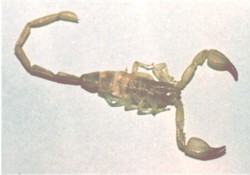Hemiscorpius lepturus
Peters, 1861
|
|
 |
|
Common names:
No common name known. The genus Hemiscorpius
was previously placed in the family Scorpionidae befor getting family status (Hemiscorpiidae). In a recent revision, this genus have been
transfered to the family Liochelidae, and the family Hemiscorpiidae has been abolished.
Distribution:
Asia (Iran, Iraq, Pakistan, Yemen).
Habitat:
Few data are available, but the species is reported from
hot and humid habitats in Iran. This scorpion is probably a crevice-dweller.
Venom:
Most scorpions have a neurotoxic venom.This
scorpion has a highly cytotoxic venom, which can cause
serious wounds and inflammations (somtimes the wounds
will look like 3. degree burns with necrosis and
blisters). These wounds are slow and difficult to heal.
The effect of the venom is very similar to the bite of
the Brown Recluse spider (Loxosceles reclusa).
No antivenom is available for this scorpion.
In Iran severe complications are known from the sting
of H. lepturus. Severe and fatal haemolysis,
secondary renal failure, deep and necrotic ulcers,
ankylosis of the joints, psychological problems and death
are reported complications. A clinical study from a
region in Iran shows that H. lepturus is
responsible for 12 % of the reported stings, but is
responsible for 95 % of the mortalities (The other
dangerous scorpion in the area is Androctonus
crassicauda)!
The LD50 value for this species is 5.81 mg/kg. This
value is not particulary low, but due to the serious
effects of the cytotoxic venom, this is a highly
dangerous species.
There are several other species in the genus Hemiscorpius There is
no available information wether these species is as dangerous as H. lepturus.
Selected litterature:
Radmanesh, M. (1990). Clinical study of Hemiscorpion
lepturus in Iran. Journal of Tropical Medicine and
Hygiene, vol. 93, pp. 327-332.
Radmanesh, M. (1998). "Cutaneous manifestations of
the Hemiscorpius lepturus sting: a clinical
study." Int. J. Dermatology, vol. 37, pp. 500-507.
On the Internet:
Some
info on Arachnodata's homepage.
General:
This species has a yellow/yellowbrown color, and a dark
stripe on the mesosoma. The lenght of the male can reach
up to 8.5 cm, while the female only reach 5 cm in lenght.
Males have a significantly longer cauda than females.
I have never heard of this species being kept in
captivity, or have never seen it offered in the pet
trade.
H. lepturus photo: Matt E.
Braunwalder/Arachnodata (C)
|